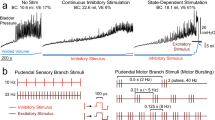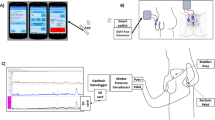Abstract
Overactive bladder (OAB) is a urological condition that is frequently observed in children and requires treatment. Standard urotherapy is usually the first line of treatment; however, children with severe OAB do not respond to this therapy. Antimuscarinic drugs may be used, but complete resolution of symptoms with this medication is low. Studies, including two randomized clinical trials, have demonstrated that electrical nerve stimulation (ENS) can be used successfully for OAB in children. Electrodes have been placed in the genitals, anus, and intravesical area, and on the tibial posterior nerve, as well as used transcutaneously or implanted during a surgical procedure. This Review will discuss the use of ENS in children with OAB, with particular focus on the putative mechanisms of action, the different ENS techniques available, and clinical results for this therapy.
Key Points
-
The etiology of overactive bladder in children is unclear, but immaturity of the cingulated gyrus is a plausible cause of this disorder
-
Electrical nerve stimulation (ENS) can be used to treat overactive bladder in children
-
ENS may act on lower urinary tract reflexes, but a supraspinal effect is likely the main mechanism of action
-
Transcutaneous parasacral ENS is an effective method for treating overactive bladder in children (level 1 evidence)
-
ENS is well tolerated in children and the rate of adverse effects is low
This is a preview of subscription content, access via your institution
Access options
Subscribe to this journal
Receive 12 print issues and online access
$209.00 per year
only $17.42 per issue
Buy this article
- Purchase on Springer Link
- Instant access to full article PDF
Prices may be subject to local taxes which are calculated during checkout
Similar content being viewed by others
References
Nevéus, T. et al. The standardization of terminology of lower urinary tract function in children and adolescents: report from the Standardisation Committee of the International Children's Continence Society. J. Urol. 176, 314–324 (2006).
Varlam, D. E. & Dippell, J. Non-neurogenic bladder and chronic renal insufficiency in childhood. Pediatr. Nephrol. 9, 1–5 (1995).
Garat Barredo, J. M., Caffaratti, S. J. & de la Peña, E. Treatment of bladder instability (non-neurogenic hyperactive bladder) in children, with tolterodine [Spanish]. Actas Urol. Esp. 28, 122–128 (2004).
Raes, A. et al. Retrospective analysis of efficacy and tolerability of tolterodine in children with overactive bladder. Eur. Urol. 45, 240–244 (2004).
Reinberg, Y., Crocker, J., Wolpert, J. & Vandersteen, D. Therapeutic efficacy of extended release oxybutynin chloride, and immediate release and long acting tolterodine tartrate in children with diurnal urinary incontinence. J. Urol. 169, 317–319 (2003).
Van Arendonk, K. J., Austin, J. C., Boyt, M. A. & Cooper, C. S. Frequency of wetting is predictive of response to anticholinergic treatment in children with overactive bladder. Urology 67, 1049–1053 (2006).
Caldwell, K. P. The electrical control of sphincter incompetence. Lancet 2, 174–175 (1963).
Alexander, S. & Rowan, D. An electric pessary for stress incontinence. Lancet 1, 1728 (1968).
Barroso, U. et al. Nonpharmacological treatment of lower urinary tract dysfunction using biofeedback and transcutaneous electrical stimulation: a pilot study. BJU Int. 98, 166–171 (2006).
Hoebeke, P. et al. Transcutaneous neuromodulation for the urge syndrome in children: a pilot study. J. Urol. 166, 2416–2419 (2001).
Hoebeke, P. et al. Percutaneous electrical nerve stimulation in children with therapy resistant nonneuropathic bladder sphincter dysfunction: a pilot study. J. Urol. 168, 2605–2607 (2002).
Tanagho, E. A. & Schmidt, R. A. Bladder pacemaker: scientific basis and clinical future. Urology 20, 614–619 (1982).
Gulur, D. M. & Drake, M. J. Management of overactive bladder. Nat. Rev. Urol. 7, 572–582 (2010).
Griffiths, D. & Tadic, S. D. Bladder control, urgency, and urge incontinence: evidence from functional brain imaging. Neurourol. Urodynam. 27, 466–474 (2008).
Ridge, R. M. A. P. & Betz, W. J. The effect of selective, chronic stimulation on motor unit size in developing rat muscle. J. Neurosci. 4, 2614–2620 (1984).
Birder, L. A., Roppolo, J. R., Iadarola, M. J. & de Groat, W. C. C-fos as a marker for subsets of visceral second order neurons in the rat lumbosacral spinal cord. Soc. Neurosci. Abstr. 16, 703 (1990).
Wang, Y. & Hassouna, M. M. Neuromodulation reduces C-fos gene expression in spinalized rats: a double-blind randomized study. J. Urol. 163, 1966–1970 (2000).
Shaker, H. et al. Role of C-afferent fibres in the mechanism of action of sacral nerve root neuromodulation in chronic spinal cord injury. BJU Int. 85, 905–910 (2000).
Gladh, G., Mattsson, S. & Lindström, S. Anogenital electrical stimulation as treatment of urge incontinence in children. BJU Int. 87, 366–371 (2001).
Dasgupta, R., Critcheley, H. D., Dolan, R. J. & Fowler, C. J. Changes in brain activity following sacral neuromodulation for urinary retention. J. Urol. 174, 2268–2272 (2005).
Andrew, J. & Nathan, P. W. Lesions on the anterior frontal lobes and disturbances of micturition and defaecation. Brain 87, 233 (1964).
Liao, K. K. et al. Effect of sacral-root stimulation on the motor cortex in patients with idiopathic overactive bladder syndrome. Neurophysiol. Clin. 38, 39–43 (2008).
Braun, P. M. et al. Alterations of cortical electrical activity in patients with sacral neuromodulator. Eur. Urol. 41, 562–566 (2002).
Fall, M. & Lindstrom, S. Functional electrical stimulation: physiological basis and clinical principle. Int. Urogynecol. J. 5, 296–304 (1994).
Ohlsson, B., Lindström, S., Erlandson, B. E. & Fall, M. Effects of some different pulse parameters on bladder inhibition and urethral closure during intravaginal electrical stimulation: an experimental study in the cat. Med. Biol. Eng. Comput. 24, 27–33 (1986).
Plevnik, S. et al. Optimization of pulse duration for electrical stimulation in treatment of urinary incontinence. World J. Urol. 4, 22–23 (1986).
Lordêlo, P. et al. Prospective study of transcutaneous parasacral electrical stimulation for overactive bladder in children: long-term results. J. Urol. 182, 2900–2904 (2009).
Lordêlo, P. et al. Transcutaneous electrical nerve stimulation in children with overactive bladder: a randomized clinical trial. J. Urol. 184, 683–689 (2010).
Godec, C., Cass, A. S. & Ayala, G. F. Bladder inhibition with functional electrical stimulation. Urology 6, 663–666 (1975).
Plevnik, S. et al. Short-term electrical stimulation: home treatment for urinary incontinence. World J. Urol. 4, 24–26 (1986).
Kralj, B. Conservative treatment of female stress urinary incontinence with functional electrical stimulation. Eur. J. Obstet. Gynecol. Reprod. Biol. 85, 53–56 (1999).
De Gennaro, M. et al. Percutaneous tibial nerve neuromodulation is well tolerated in children and effective for treating refractory vesical dysfunction. J. Urol. 171, 1911–1913 (2004).
Humphreys, M. R. et al. Preliminary results of sacral neuromodulation in 23 children. J. Urol. 176, 2227–2231 (2006).
Trsinar, B. & Kraij, B. Maximal electrical stimulation in children with unstable bladder and nocturnal enuresis and/or daytime incontinence: a controlled study. Neurourol. Urodyn. 15, 133–142 (1996).
Malm-Buatsi, E. et al. Efficacy of transcutaneous electrical nerve stimulation in children with OAB refractory to pharmacotherapy. Urology 70, 980–983 (2007).
Bower, W. F., Moore, K. H. & Adams, R. D. A pilot study of the home application of transcutaneous neuromodulation in children with urgency or urge incontinence. J. Urol. 166, 2420–2422 (2001).
Hagstroem, S. et al. Transcutaneous electrical nerve stimulation for refractory daytime urinary urge incontinence. J. Urol. 182, 2072–2078 (2009).
Roth, T. J. et al. Sacral neuromodulation for the dysfunctional elimination syndrome: a single center experience with 20 children. J. Urol. 180, 306–311 (2008).
Author information
Authors and Affiliations
Contributions
U. Barroso and P. Lordêlo made equal contributions to researching, discussing, writing, reviewing and editing this manuscript.
Corresponding author
Ethics declarations
Competing interests
The authors declare no competing financial interests.
Rights and permissions
About this article
Cite this article
Barroso, U., Lordêlo, P. Electrical nerve stimulation for overactive bladder in children. Nat Rev Urol 8, 402–407 (2011). https://doi.org/10.1038/nrurol.2011.68
Published:
Issue Date:
DOI: https://doi.org/10.1038/nrurol.2011.68
This article is cited by
-
Contemporary Management of Urinary Tract Infections in Children
Current Treatment Options in Pediatrics (2022)
-
The value of synchro-cystourethrometry for evaluating the relationship between urethral instability and overactive bladder
International Urology and Nephrology (2018)
-
Bladder and bowel dysfunctions in 1748 children referred to pelvic physiotherapy: clinical characteristics and locomotor problems in primary, secondary, and tertiary healthcare settings
European Journal of Pediatrics (2017)
-
The management of childhood urinary incontinence
Pediatric Nephrology (2015)



